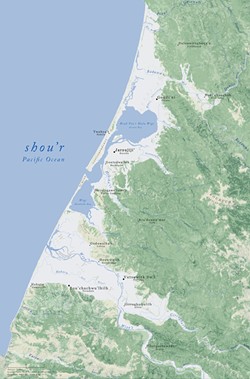[
{
"name": "Top Stories Video Pair",
"insertPoint": "7",
"component": "17087298",
"parentWrapperClass": "fdn-ads-inline-content-block",
"requiredCountToDisplay": "1"
}
]
Editor's note: The following was written and submitted in response to last week's cover story, "Broken Trust."
Most of us know that what we call Humboldt Bay was part of the territory of the Wiyot people. And most us of know of the terrible mass killing that occurred in 1860 on what was called Indian Island. But most of us do not know much more about the Wiyots and what has happened to their homeland over time. Here is part of that story.
White settlers first arrived on Humboldt Bay in the spring of 1850, hoping to set up towns on the bay that could supply the gold miners on the Trinity and Klamath rivers. Within a few weeks one group of whites had burned the Wiyot village located just south of Spruce Point and killed the two Wiyot boys who had led them there. The whites established a small town on the village site called Humboldt City only to abandon it after a year because other towns were more successful in supplying the miners. The location remained vacant until the 1950s, when a new community was built there. It was called King Salmon.
One part of the Wiyot Tribe lived in a string of villages along the lower Eel River. In early 1852, two whites were found murdered near the mouth of the Van Duzen River. Natives were blamed for the killings, and soon the settlers on the lower Eel decided to retaliate. The settlers held a community meeting to decide what they would do to the Wiyots, and "it was unanimously decided to commence war upon them immediately." The Eel River whites wrote "to the people of Uniontown [Arcata] and Humboldt Bay," asking that the citizens from those places join in the attack. Shortly thereafter, Wiyot villages near Eureka, at the mouth of Elk River and along the lower Eel were attacked, and 15 to 20 Wiyots were killed.
The killings continued. A Wiyot woman named Jane Searson who survived the attacks later said, "... When the white people began to settle they were friendly. They got along with us. Later trouble started, it seems like it started over nothing. I and my people was chased from place to place. One morning we hear that three men came up the river [and] they had guns. About two days later ... we heard shots up the river. We commenced moving what we had. They (white men) burnt our house, destroyed everything that we did not take. Most all my relatives was killed at that time ... My husband said that this murdering was done for the purpose of getting our land."
Another Wiyot woman, Carrie Seidner, compiled a list of white men from the lower Eel and southern Humboldt who "were old settlers and they were bad ones they kill Indians where they could find one all over the valy [sic]." The last name on her list was Seth Kinman, a buckskin-clad rifleman who has been celebrated in Humboldt County folklore for well over a century.
In the late 1850s the inland tribes, including the Nongatls, Whilkuts and Hupas, defended their homelands by force of arms. In response, ranchers from the Hydesville area formed a military unit in early 1860 called the Humboldt Volunteers and petitioned Gov. John D. Downey to muster the unit into state militia. When the governor hesitated, various whites drew up a plan to force him to act. At the end of February, with still no word from the governor, they put their plan into action. It resulted in a dozen or more attacks on Wiyot villages, all the way from Tulawat, on what was called Indian Island, southward to Rio Dell. No one at the time tallied up the casualties, but at least several hundred Wiyots must have died. One of the organizers of the Humboldt Volunteers later wrote to Downey, threatening that if the unit was not now made part of the militia, "the little mess at Indian Island near Eureka is only a beginning if we can't get our just protection." Despite this attempt to intimidate Downey, the governor refused to give the Volunteers militia status.
But nothing was done to bring the murderers to justice. The county sheriff, who was believed to be one of the plotters, spent the days following the massacres collecting affidavits from ranchers who had lost cattle to the inland tribes, rather than attempting to arrest the murderers. Many of the surviving Wiyots wound up at Fort Humboldt, where they were collected in a tiny corral in which many of them died. Eventually, they were moved to a reservation near the mouth of the Klamath River that was run like a concentration camp. There, more Wiyots died. In time, the Native people were moved to other reservations, and eventually the surviving Wiyots made their way back to their homeland, but there was no homeland left. Whites had taken over all of the Wiyots' land and they had to find places to live as best they could.
Searson, the Wiyot woman who had survived the attacks on the Eel, knew who the Indian Island massacre perpetrators were. Later, she would see "several people pass by my house that was in the massacre." She must have wondered if they would try again.
Somehow some of the Wiyots who had been on the reservations managed to raise a little money. With it, they bought 80 acres of land on Cock Robin Island, which lay on the lower Eel. There, in 1869, they established "the Indian Town of Cockrobin," and filed a copy of a map of the town with the county recorder. The map showed 20 town lots for families and one larger lot, which was labeled "City Garden."
In 1879, a tremendous flood hit the lower Eel. Ranches went underwater. Cattle drowned. One family spent a night atop a huge stump. Another climbed into their attic to escape the rising water. The next morning the area looked like "an inland sea." Then along came a canoe. In it were Tom Coats and other Wiyots from Cock Robin Island — they had come to see if the white "folks were safe."
Tom Coats and the other Wiyots had rules of conduct that would today put most of us to shame. One rule that now seems appropriate to recall is very simple: "Stranger must wait until place to sit is indicated."
Jerry Rohde (he/him) is an ethnogeographer and historian who writes about Humboldt County. His most recent book, Both Sides of the Bluff, is a history of the lower Eel and Table Bluff.
Comments
Showing 1-1 of 1
Latest in Views
Readers also liked…
-
Hope
- Sep 7, 2023
-
California Says No to Privatizing Medicare
- Sep 21, 2023


































